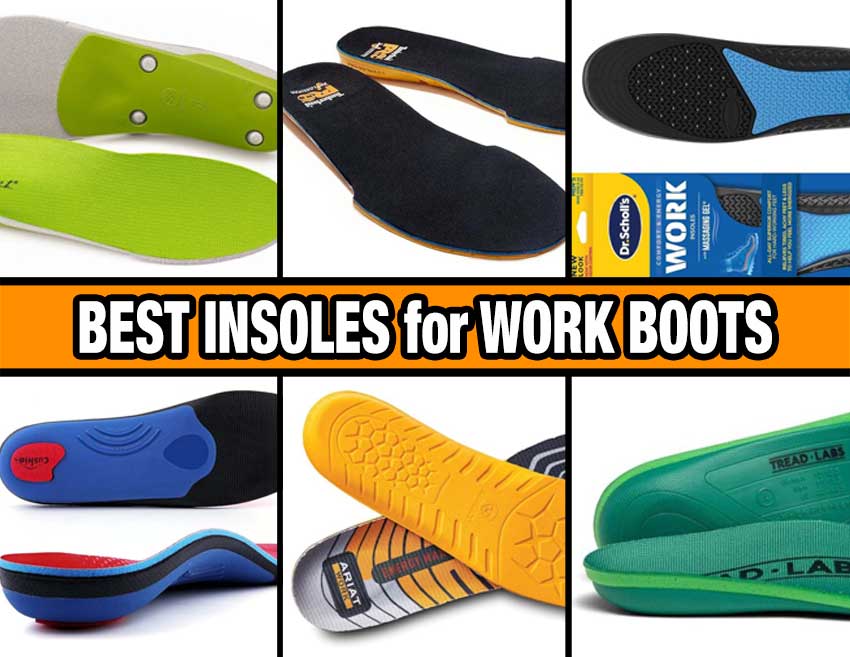If your dogs are barking at the end of a full workday, you don’t need to replace your work boots to find relief. Often, all you need is to find the best insoles for your work boots. But don’t buy any old set. When it comes to wearing work boots, all insoles aren’t the same, and what’s best for high arches can be painful for flat feet. Likewise, an insole that soothes plantar fasciitis may do little to alleviate the pain of bunions. Your insole needs can also vary depending on whether you spend your days standing on a concrete factory floor or trudging through a construction site.
Whether you’re looking for new insoles for the worn out ones in your favorite work boots or want to upgrade the stock ones that came with a brand new pair of boots, we have the best insoles for work boots to suit your needs.
- Best Overall: Superfeet All-Purpose Support High Arch Insoles GREEN – Buy from Amazon
Jump to these Insoles ↓ - Best Cushioned: Timberland PRO Anti-Fatigue Technology TB091621827 – Buy from Amazon
Jump to these Insoles ↓ - Best Gel: Dr. Scholl’s Work Massaging Gel Advanced Insoles 11017570110 – Buy from Amazon
Jump to these Insoles ↓ - Best Insoles for Boots on Concrete: Walkomfy Heavy Duty Orthotics – Buy from Amazon
Jump to these Insoles ↓ - Best Square Toe: ARIAT Energy Max Work Square A10032203-15 – Buy from Amazon
Jump to these Insoles ↓ - Best Steel Toe: Walk-Hero Memory Foam Insoles 4332430116 – Buy from Amazon
Jump to these Insoles ↓ - Best High Arch Support: Tread Labs Ramble Insoles RR – Buy from Amazon
Jump to these Insoles ↓ - Best Flat Feet Support: Samurai Sumos Super-Padded Orthotics – Buy from Amazon
Jump to these Insoles ↓ - Best Plantar Fasciitis: Brison Work Insoles 03303345 – Buy from Amazon
Jump to these Insoles ↓
Also In This Article
- How We Picked the Best Insoles for Work Boots
- Best-Selling Insoles for Work Boots
- Best Insoles for Work Boots Buying Guide
- Frequently Asked Questions About Insoles for Work Boots
- Why You Can Trust Pro Tool Reviews
Related Content
- Best Work Boots
- Best Cowboy Boots
- Best Work Clothes for Hot Weather
- Best Contruction Clothing Brands for Men and Women
How We Picked the Best Insoles for Work Boots
We kept several factors in mind when making our list of the top 10 work boots. Since feet come in various shapes and sizes, we included insoles on our list to suit high arches, flat feet, and everything in between. Since many people use insoles to relieve foot ailments, we included insoles designed for people dealing with bunions, corns, and plantar fasciitis. Work boots see more use than any other footwear in your closet. So, we chose insoles that can withstand 40-plus hours a week of punishment and still last for six to 12 months.
Best Overall Insoles for Work Boots
Superfeet All-Purpose Support High Arch Insoles GREEN
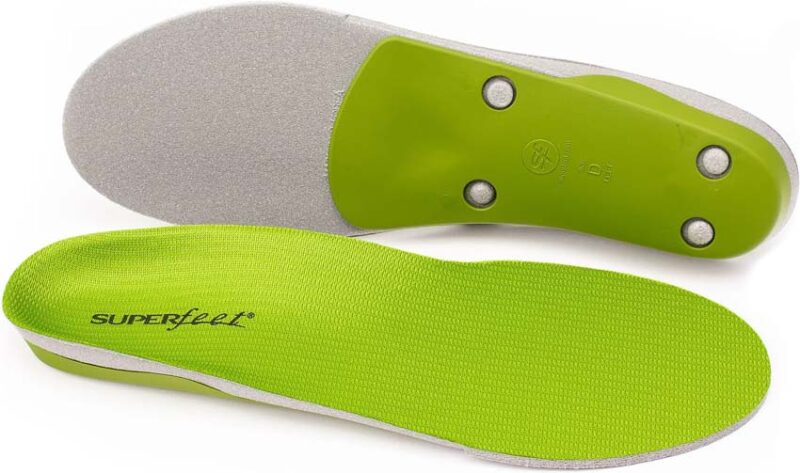
The design of Superfeet insoles hasn’t changed a whole lot since they debuted back in the 1970s. But that’s because they work so well. Superfeet insoles combine a high-density foam footbed that absorbs impact and cushions your feet with a high arch for support and a rigid heel cup that keeps your feet stable while you work. There’s also an odor-control coating, which keeps your feet from getting smelly even after long hours in your boots. We also like the cut-to-fit design. This makes them easy to customize to suit the size and shape of your foot. Yes, Superfeet insoles are among the priciest, but they’ll also outlast most of the more affordable insoles out there.
Key Features
- Trim to fit design
- Odor control coating
- Rigid arch support
Specifications
- Material: High-density foam and rigid orthotic
- Sizing: Cut to fit
- Profile: High arch support
Price: $54.95
Best Cushioned Insoles for Work Boots
Timberland PRO Anti-Fatigue Technology Replacement Insole TB091621827
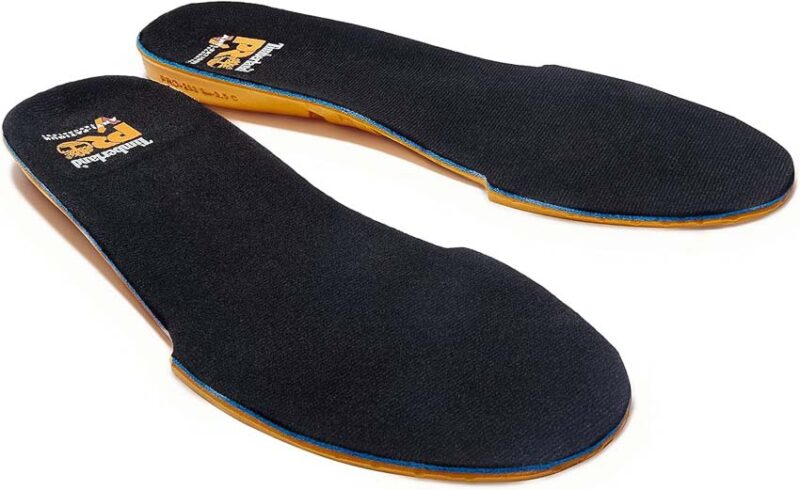
These inserts are among the beefier ones on the market at nearly a 1/2 inch thick. This thicker material, coupled with its inverted cone design, absorbs shock as you walk. It also gives these insoles plenty of rebound. So, your legs won’t feel as tired at the end of the day. Timberland Pros also offers good arch support. Furthermore, they have a top layer that wicks away moisture, so your feet don’t get sweaty. Just keep in mind that their added thickness probably makes them a no-go if you’re looking for a set of replacement insoles for a pair of tight-fitting boots.
Key Features
- Thick cushioning
- Moisture wicking materials
- Durably constructed
Specifications
- Material: Molded high-density foam
- Sizing: Trim to fit
- Profile: Moderate arch support
Price: $29.99 – $46.40
Best Gel Insoles for Work Boots
Dr. Scholl’s Work Massaging Gel Advanced Insoles 11017570110
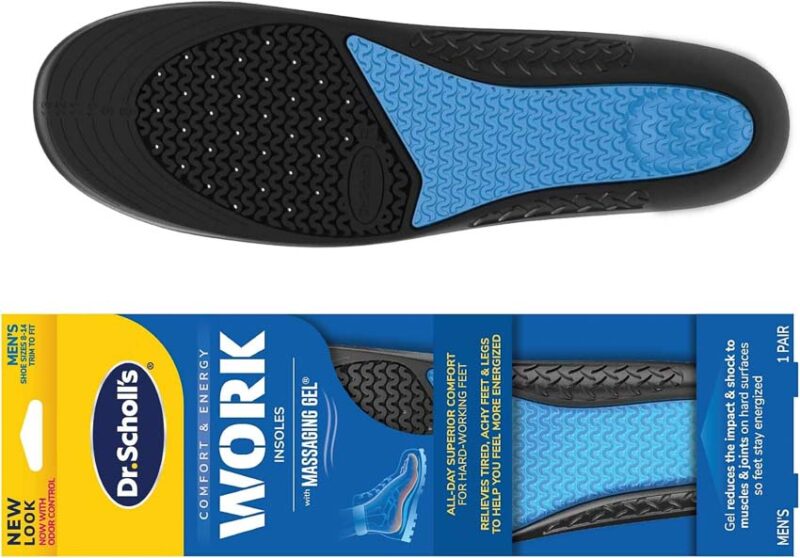
While you might equate Dr. Scholl’s with insoles for your dress shoes, they make some great budget-priced insoles for work boots too. With its unique wave cushioning design, this set of insoles helps absorb the impact of your boots pounding hard surfaces like concrete or hard dirt. It also creates rebound, so your legs feel fresher come the end of the work day. And since they’re thinner than other brands, they’re a good choice if you don’t have a lot of room to spare in your boots. Along with being slimmer, they’re also cheaper, making them a great budget-priced insole.
Key Features
- Wave pattern absorbs impacts
- Thinner design
- Affordably priced
Specifications
- Material: Gel and high-density foam
- Sizing: Trim to fit
- Profile: Moderate arch support
Price: $12.54
Best Insoles for Work Boots on Concrete
Walkomfy Heavy Duty Support Pain Relief Orthotics
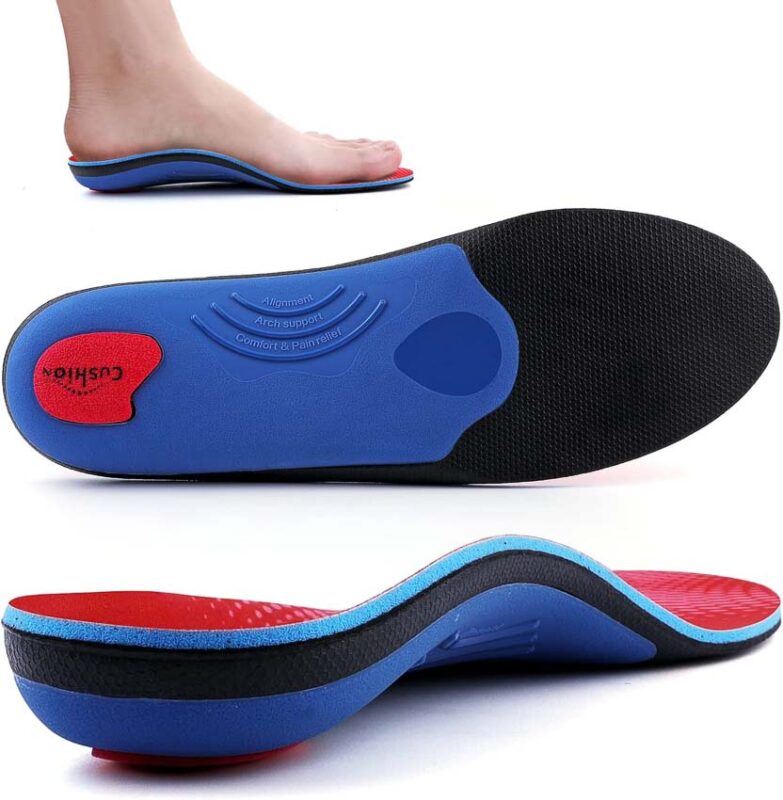
The first thing you’ll notice about Walkomfy’s heavy-duty insoles is how thick they are. The footbed consists of a layer of EVA covered by memory foam. This cushioned layer sits atop a rigid orthotic that features ample arch support and a deep heel cup for stability. As if that’s not enough shock absorption, there’s also an extra heel pad attached to the bottom of the orthotic. In short, they provide about as much support, shock absorption, and rebound as any insole on the market. That’s exactly what you want if your job requires you to spend eight hours on concrete factory floors.
Key Features
- Maximum shock absorption design
- No trimming required
- Deep heel cup for stability
Specifications
- Material: High-density foam and rigid orthotic
- Sizing: No trimming required
- Profile: High arch support
Price: $32.39
Best Insoles for Square Toe Work Boots
ARIAT Energy Max Work Square Insole A10032203-15
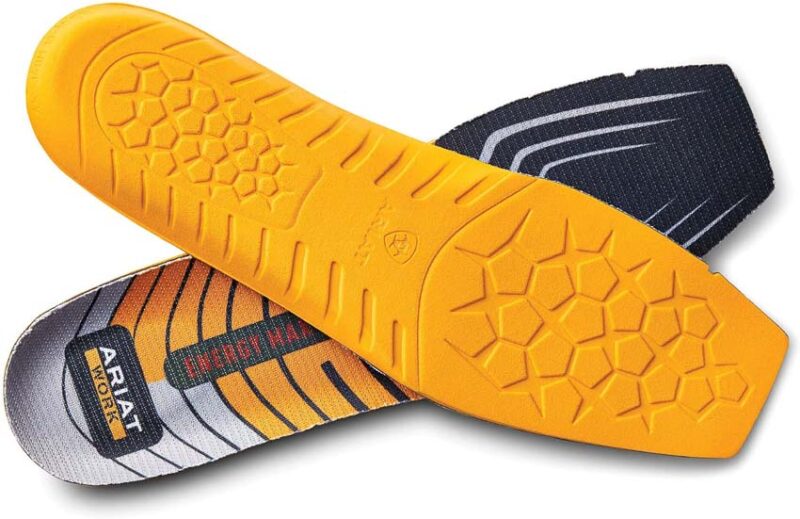
You don’t have to fit a rounded insole into a square boot. These insoles from one of the best-known names in cowboy-style work boots will fit your square-toed boots, be they Ariat or some other boot brand, without the need for a pair of scissors. Along with being tailored specifically for square-toed boots, the Ariat Energy Max square insoles have a thick high-density foam layer that offers good rebound while distributing pressure throughout your foot. There’s also an open-cell design that promotes airflow. Additionally, it has a moisture-wicking liner with an antimicrobial treatment that prevents your feet from getting sweaty and smelly.
Key Features
- Square toe shape
- Antimicrobial moisture-wicking liner
- Fits a variety of boot brands
Specifications
- Material: High-density foam
- Sizing: No trimming required
- Profile: Moderate arch support
Price: $25.08
Best Insoles for Steel Toe Work Boots
Walk-Hero Memory Foam Insoles 4332430116
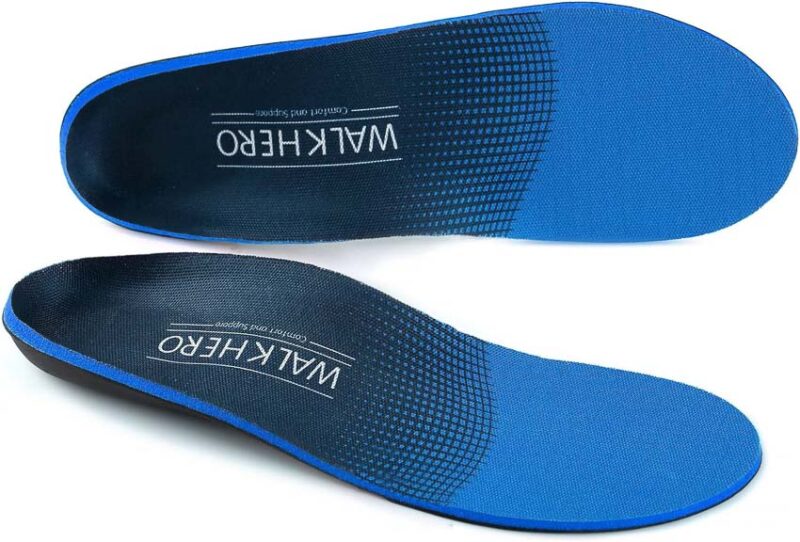
While steel toe work boots may protect your little piggies from getting crushed by falling objects, that rigid toe also restricts the natural movement of your feet, which is why they can be so uncomfortable to wear for long periods. Walk-Hero’s insoles have a design that can help alleviate that pain. A deep heel cup helps stabilize the foot so it won’t move around in the toe of your work boot. They’re also very thin and have low arch support, so they won’t crowd the toe-box and cause the top of your foot to rub painfully against the cap. Plus, they come in a broad range of sizes, so you don’t need to trim them.
Key Features
- Deep heel cup for stability
- Nom trimming necessary
- Thin design won’t crowd toe box
Specifications
- Material: High-density foam
- Sizing: No trimming required
- Profile: Low arch support
Price: $19.99
Best High Arch Support Insoles For Work Boots
Tread Labs Ramble Insoles RR
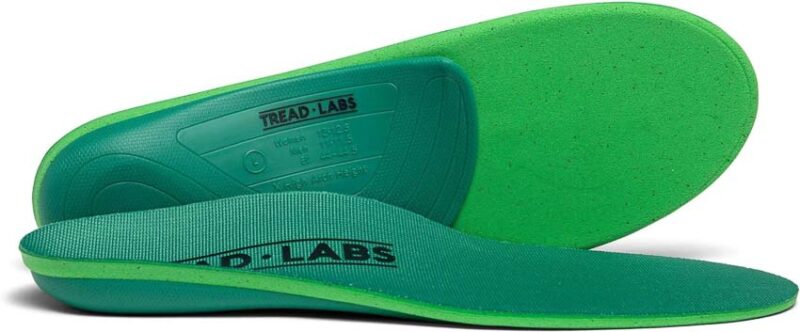
Ramble understands that feet come with a variety of different arch heights. These insoles come in four different arch support options, including extra high for those with sky-high arches. Ramble insoles consist of two separate pieces, a top cover of high-density foam that cushions your foot and a rigid heel cup and arch support that distributes your weight evenly across your foot. The two pieces attach via a strip of velcro. While a pair of Ramble insoles don’t come cheap, the top cover piece is replaceable and the replacement covers are affordable.
Key Features
- Four arch support options
- Replaceable cover
- Rigid heel cup for stability
Specifications
- Material: High-density foam cover and rigid orthotic
- Sizing: No trimming required
- Profile: Four arch support options
Price: $60
Best Flat Feet Support Insoles For Work Boots
Samurai Insoles Sumos Super-Padded Orthotics for Flat Feet
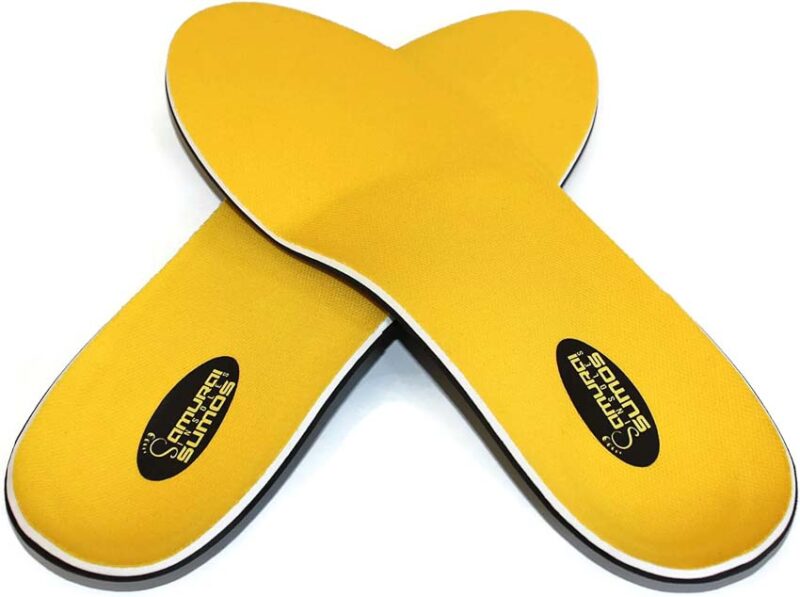
Most insoles for work boots include moderate to high arch support. While that’s just fine for those who have high arches, it’s murder on the feet for someone who is flat-footed. Samurai’s Sumos are an exception. Designed by a flat-footed podiatrist, these insoles trade the exaggerated arch support of other insoles for much lower arches. They also use a stiff orthotic insert that’s hidden inside the insole to provide bounceback that reduces leg fatigue. They also come in many sizes, so you won’t need to cut them to fit your boots.
Key Features
- Low arch support for flat feet
- No trimming required
- Rigid heel cup for stability
Specifications
- Material: High-density foam cover and rigid orthotic
- Sizing: No trimming required
- Profile: Low arch support
Price: $48.99
Best Plantar Fasciitis Insoles For Work Boots
Brison Work Insoles 03303345
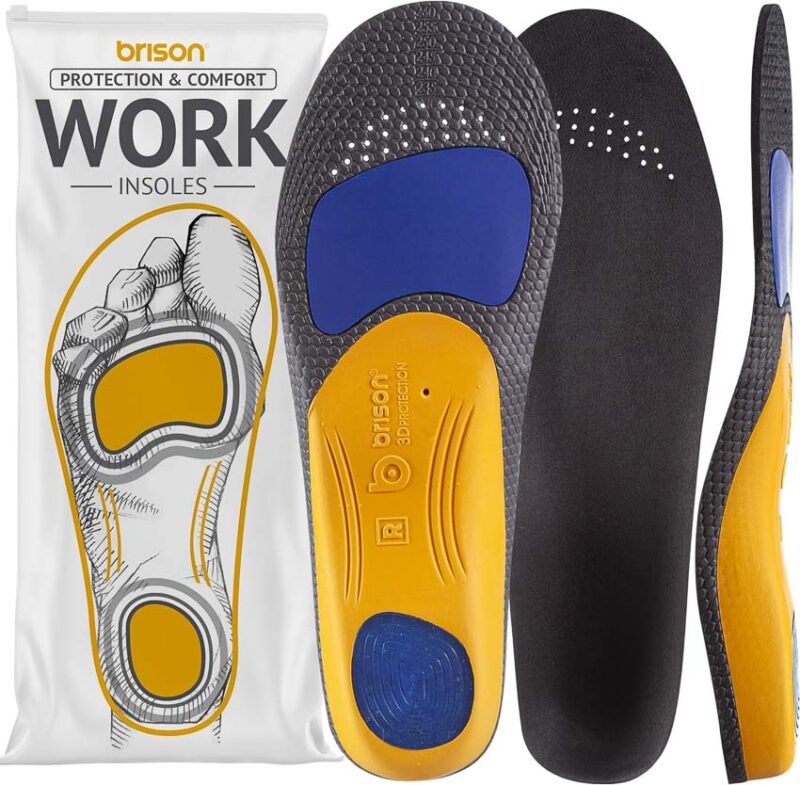
Plantar fasciitis can be debilitating, especially if your job requires you to be on your feet all day long. Brison Work insoles are designed to alleviate that pain by providing reinforced arch support that takes pressure off the band of fascia that extends from the ball of your foot to the heel. They also have a reinforced heel cup that stabilizes the foot while also cushioning impact so that plantar fascia pain in your heel doesn’t hurt so much every time you take a step. A layer of high-density foam and a cushion footpad at the ball of the foot provide additional comfort for the whole foot.
Key Features
- Arch support takes pressure off heel
- Cushioned heel cup relieves plantar fasciitis pain
- Additional cushioning at ball of foot
Specifications
- Material: Microfiber cover, High-density foam, and rigid orthotic
- Sizing: Trim to size
- Profile: High arch support
Price: $39.99
Best-Selling Insoles for Work Boots
Now that you’ve had a chance to peruse our top picks, here’s a quick overview of some best-selling insoles for work boots.
Best-Sellers at Amazon
- CRUVHEAL 220+ lbs Plantar Fasciitis High Arch Support Insoles – $29.99
- LTOHOE Memory Foam Work Boot Insoles for Men YC001-M-Black-10 – $9.99
- Copper Fit Unisex Work Gear Comfort Insoles CFWKINOSM – $9.99
- STSVZORR Arch Heavy Support Pain Relief Orthotics for Men and Women – $37.49
- CRUVHEAL Work Comfort Orthotic Insoles for Men and Women – $19.99
Best Insoles for Work Boots Buying Guide
When selecting insoles for your work boots, several factors come into play: What they’re made of; the type of boots you wear; the shape of your foot; the kind of work you do, and the list goes on. With that in mind, here’s what you should know before you buy.
Material and Composition
Insoles consist of a soft footbed that cushions your feet, made of either high-density foam, gel, or a combination of the two. These soft materials sit on top of a rigid shell that provides support and stability.
Memory Foam vs. Gel-based
Most insoles either use memory foam or gel to provide comfort in the footbed. Memory foam molds to your feet, cushioning them while alleviating any pressure points. Since Memory foam is also firm, it also provides excellent arch support, making it a good choice for those who suffer from plantar fasciitis.
Gel insoles provide the best shock absorption and rebound, which is why you’ll often find them used in athletic shoes. However, gel isn’t as durable as high-density foam and will flatten more quickly over time.
Breathable Fabrics and Antimicrobial Properties
When our feet get hot, they tend to start sweating, which creates bacteria and with it unpleasant odors. Since high-density foam typically isn’t very breathable, many manufacturers put tiny holes throughout the insole to allow heat to escape and prevent your feet from sweating. Most insoles also have an antimicrobial treatment to prevent the growth of odor-causing bacteria.
Arch Type Support
Insoles offer different degrees of arch support to suit feet of varying shapes and sizes from those who have high arches to those with flat feet.
High Arch, Neutral, or Flat Feet Specific Insoles
If you want an insole that’s going to give your feet the most benefits, you need to buy a pair that matches the shape of your foot. If you have high arches, look for insoles with more pronounced arch support that will distribute your body weight across your entire foot, taking pressure off the ball and heel of your foot.
For average arches, look for a gel or high-density foam insole that supports your arch while distributing your weight evenly from the ball of the foot to the heel.
Those with flat feet have the entire sole of their foot touching the ground when they stand. A good insole for a flat foot will have a low but firm arch that provides good support without causing pain.
Stability and Support Dynamics
Your feet set the tone when it comes to how your body supports itself when you stand up. If your foot and ankle are out of alignment, your knees and hips have to compensate, leading to stiffness and pain.
While having cushioning in an insole is important to keep the soles of your feet from getting sore, so too is having a certain amount of rigidity to provide your feet with ample support as you stand and walk throughout the workday. A good insole will keep your feet and ankle properly aligned, by providing even support over your foot and, if needed, help correct any overpronation (your foot rolling inward with each step) or supination (your foot rolling outward with each step) you might have.
Durability and Lifespan
Insoles will wear out long before your boots do. Understanding just how long is key to keeping your feet comfy all the livelong day.
Wear and Tear Indicators
Even the best insoles will eventually wear out, causing you to feel pain on the soles of your feet, ankles, knees, and even hips. There are a few ways to determine if your insoles are through before they begin to take a toll on your body.
First, check their appearance. If the cover is discolored and the logo is no longer legible, it’s probably time to replace the insole. Insoles that are cracked, torn, or worn through are also done. Over time, the gel and high-density foam will compress to the point that they no longer cushion your feet the way they once did. If you can see the impression of your foot in the insole, it’s time to replace them. Finally, give those insoles the sniff test. If they stink, throw them out and get new ones.
Insole Replacement Frequency
How much mileage you can expect to get out of your insoles depends on a few factors, including quality and the amount of time you spend in your boots each day. If you’re wearing your work boots all day long and spend a lot of time on your feet, expect to get between 6 and 12 months of life out of those insoles before you’ll need to replace them. Cheaper insoles will fail toward the six-month end of this range while pricer inserts should give you around a year of use before they’re done.
Comfort and Cushioning
An insole’s purpose is to keep your feet pain-free through the workday. They do this by cushioning the soles of your feet, distributing pressure evenly across your foot, and absorbing the shock with cushioning.
Heel Cupping and Pressure Distribution
Heel cups are made of a rigid or firm material that cradles the heel to provide stability by preventing your foot from pronating to one side or the other. They also provide cushioning for the heel, helping to alleviate pain caused by such ailments as plantar fasciitis.
Work boot insoles also provide some level of arch support, helping to distribute your weight across your entire foot and not just the ball and heel.
Shock Absorption Features
One of the ways insoles keep your feet from getting sore and tired is by absorbing and dispersing energy created by the impact created by walking and running. Insoles use either gel or high-density foam or a combination of the two to accomplish this. In addition to absorbing impact, this material also provides some bounce that returns energy to your legs, helping to reduce leg fatigue over long workdays. Generally speaking, the thicker the insole the better its rebound and shock-absorbing qualities.
Why and When to Use Insoles for Work Boots
Enhancing Boot Lifespan
While insoles don’t have a dramatic impact on how long your boots last, they can ease the wear and tear on them by correcting any abnormalities in your gait.
Reducing Wear to the Outer
When the wheels aren’t aligned properly on your car, the tires can wear unevenly, shortening their lifespan. The same goes for the tread on your work boots. When you have pronation or supination, you put more wear on one section of the boot outsole, causing it to wear out more quickly. Insoles that have stabilizing orthotics built into them, such as a heel cup, prevent pronation and supination, ensuring you get even wear across the boot tread, so you can get the most out of them.
Addressing Foot Ailments
Aftermarket shoe insoles for your work boots can help alleviate the pain caused by plantar fasciitis, bunions, corns, and heel spurs and even help prevent these conditions from worsening.
Plantar Fasciitis and Heel Spurs
If you’re suffering from plantar fasciitis or heel spurs look for an insole with good arch support and ample cushioning in the foot bed. That arch support will distribute pressure across the entire foot, reducing tension on the ligament and helping to ease the pain in your heel.
Bunions and Corns Alleviation
Bunions are caused by excessive pronation that causes the bone to build up where your big toe meets your foot. Insoles with good arch support and a deep heel cup help correct that pronation, preventing the formation of bunions or alleviating pain from existing ones.
Since insoles stabilize your foot inside the boot, they can also prevent the skin from rubbing against the interior of the boot, preventing painful blisters called corns.
Performance and Fatigue Reduction
A good set of insoles can make your feet feel more secure inside your boot so you can move through your workday with more confidence. They’ll also help to absorb impact, so your legs feel less tired by the end of the day.
Enhanced Stability for Challenging Tasks
If your job requires a good set of workboots, chances are you’re doing a lot of dynamic movements all day. You might be climbing ladders, walking up and down inclines, tromping through loose and uneven dirt, squatting, kneeling, and a whole host of other movements that affect your feet. A good set of insoles provides stability, helping to keep your feet blister-free as you perform all these movements.
Energy Return and Reduced Foot Fatigue
Insoles help to reduce fatigue not just on the soles of your feet, but also on your ankles, knees, and hips. They do this by absorbing impact and dissipating it evenly over your feet. Insoles also combine with the boot’s midsole to provide rebound, sending energy back to your legs, and adding spring to your step so they feel less tired at the end of the day.
Safety Considerations When Using Insoles for Work Boots
Ensuring Proper Fit within the Boot
Sizing is crucial when selecting a new insole to ensure you get the most out of it. An insole that doesn’t fit properly can end up causing more problems for your feet while potentially making you more susceptible to injury and slips and falls.
You have a choice between insoles that come in specific sizes and those that are trimmable. If you choose the former, keep in mind that sizes can vary up to half a size in either direction from brand to brand, so make sure to read the sizing information about that insole before ordering it.
Trimmable insoles typically come in a size range, such as 9 to 11, so choose an insole with a range that covers your shoe’s size. Use your boot’s existing insole as a template for cutting your new insole to size.
Avoiding Overlapping or Excess Material
A replacement insole should fit inside your boot without having excess material crowding your foot and causing discomfort. Trim away any excess material with a pair of scissors, so the insoles fit properly. If there is too much to trim or you purchased insoles that are not designed to be trimmed, then return them and get a smaller size.
Maintenance and Hygiene
Periodically cleaning your insoles can help deodorize them and extend their life. Before cleaning them, check the manufacturer’s care instructions or you could end up damaging the material or inadvertently stripping away antimicrobial treatments that prevent odor-causing bacteria. Unless instructed by the manufacturer, never throw a pair of insoles in the washing machine. Instead, hand wash them by gently scrubbing them with water and dish soap, then rinsing them.
Matching Insole to Work Requirements
High Impact vs. Static Jobs
Choose an insole that matches the demands of your job. If your job involves a lot of walking over hard or uneven surfaces, look for an insole with a deep heel cup that will help stabilize your foot in your boot, preventing supination or overpronation, and a rigid orthotic insole that will transfer the shock from those high impact activities throughout your foot. Go with a gel insole that will give you maximum shock absorption and rebound.
If your workday requires you to spend most of the day standing in one place, look for an insole with plenty of arch support, so your weight is evenly distributed rather than directed to the foot or the heel. You’ll also want an insole that has a footbed with ample cushioning for all-day comfort.
Frequently Asked Questions About Insoles for Work Boots
How often should I replace the insoles in my work boots?
You’ll want to change the insoles about every six to 12 months. Whether you change them twice a year or once a year depends on the quality of the insoles, how many hours you put into them daily, and what kind of abuse they take from your line of work.
Can a single pair of insoles be used in multiple work boots?
You can use the same pair of insoles in different work boots, with a few caveats. Make sure the insoles fit properly in each set of workboots. Also, if you’re using insoles in multiple sets of footwear, you’re likely using them a lot, so expect them to wear out more quickly. With that in mind, it may make sense and be more convenient to simply buy a set of insoles for each pair of work boots you own.
Are there specialized insoles for specific job roles or industries?
Insole manufacturers don’t make insoles designed for any one job or industry. Instead, they tailor their products in different ways. Some insoles focus on stability for those who work on construction sites, farms, and other places with loose uneven ground, while others are built to offer maximum rebound and shock absorption for those who spend their days on hard concrete floors.
What if the insoles make my boots feel too tight?
If your boots feel tight after installing your insoles, they’re either too thick or perhaps have an arch support that’s too pronounced. You’ll need to remove them and replace them with a thinner type of insole or one that has a lower arch. When you’re buying a new pair of insoles, look for a pair that is similar in thickness to the stock insoles that are currently inside the boot (unless, of course, your boots are too loose with those existing insoles).
Why You Can Trust Pro Tool Reviews
Ever check out a “review” site and you can’t tell if they actually tested anything or if they’re just “recommending” the Amazon top sellers? That’s not us. We won’t recommend anything unless we’d actually use it ourselves, and we don’t really care who the primary retailer is. It’s all about giving you a legitimate recommendation and our honest opinion of each product.
We’ve been in business since 2008 covering tools, writing reviews, and reporting on industry news in the construction and lawn care industries. Our Pro reviewers work in the trades and have the skills and experience to know whether tools can perform well in the field.
Each year, we bring in and review more than 350 individual products. Our team will put our hands on hundreds of additional tools at media events and trade shows throughout the year.
Pro Tool Reviews consults with innovators in the technology and design of tools to gain a broader grasp of where these products fit and how they work.
We work with more than two dozen professional contractors around the United States who review products for us on real job sites. We consult with them extensively on testing methods, categories, and practical applications.
Our site will provide more than 500 pieces of new content this year absolutely free for our readers. That includes objective evaluations of individual tools and products.
The end result is information you can trust because of the editorial, scientific, and real-world professional experience we collectively utilize each and every time we pick up and test a tool.

